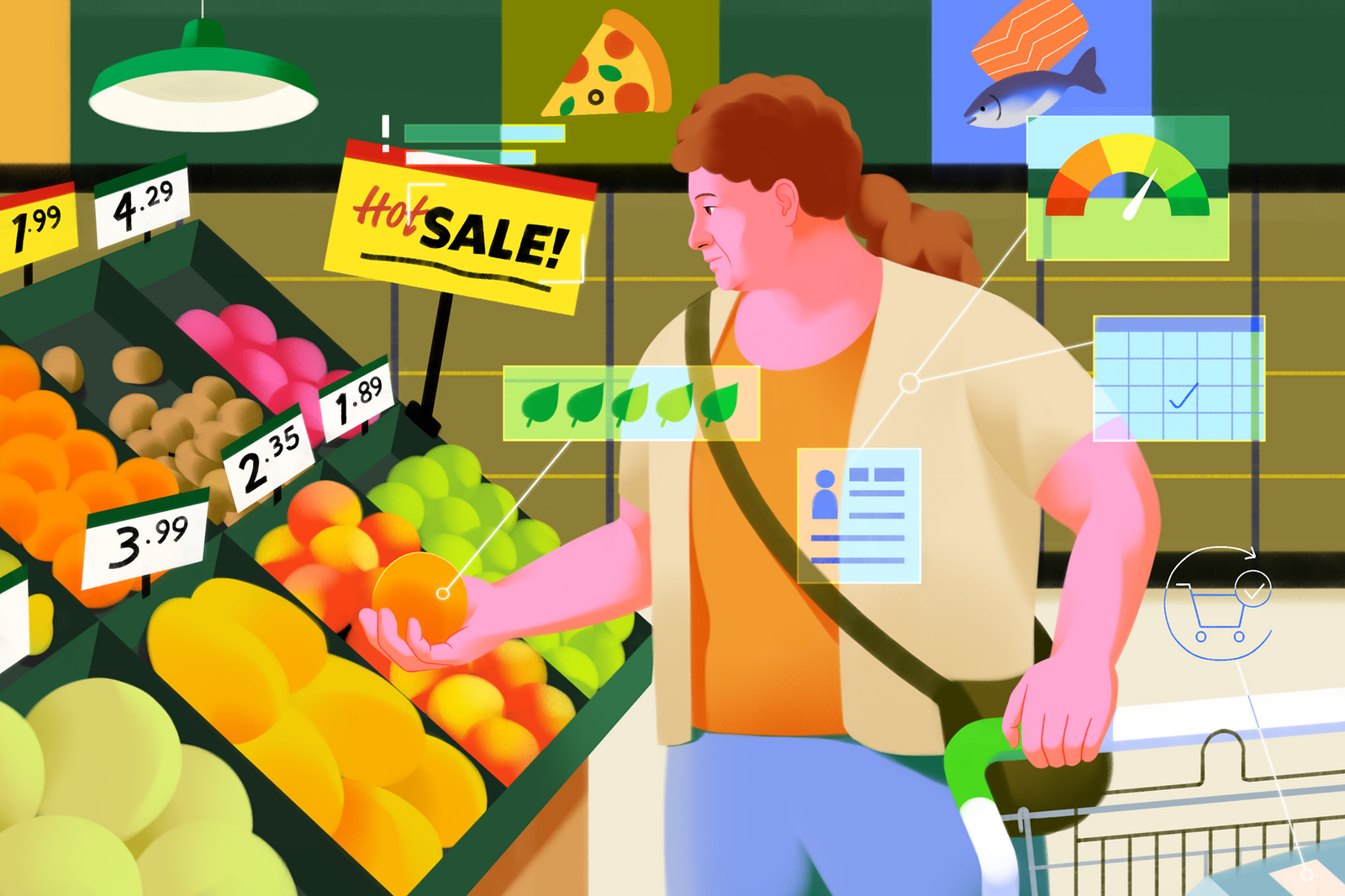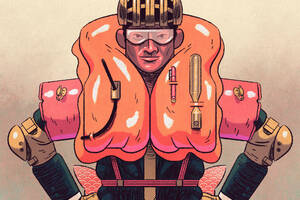Finance & Accounting Marketing May 1, 2024
The Clues to Creditworthiness Hiding in Your Grocery Cart
Grocery habits—like buying mortadella beef or scheduling regular shopping trips—can be as useful as credit scores at predicting who will reliably repay loans.

Yifan Wu
Nearly 26 million people in the U.S. lack a credit score. Worldwide, more than a billion are “unbanked.” Without a credit history, individuals find themselves in a vicious cycle when they seek a short-term loan or other financial help: they apply for credit but the issuer, lacking a standard measure to estimate their creditworthiness, rejects them.
“You don’t get marginalized out by accident,” says Eric Anderson, a professor of marketing at the Kellogg School. “If you think about it as a big funnel, the unbanked customers aren’t attracted into the funnel. Then if they do happen to make it into the funnel, they get kicked out again, because they don’t have credit scores.”
But what if financial institutions could use other, more creative measures to predict who will pay back their loans? They might acquire new customers, while improving access to credit. This possibility has businesses, scholars, and policymakers asking whether behaviors not directly tied to income or credit history—like, for instance, how someone shops for groceries—can predict responsible loan-repayment habits.
New research by Anderson and his colleagues Jung Youn Lee of Rice University and Joonhyuk Yang of the University of Notre Dame explores this idea. The team overlays data from a grocery store and a credit-card company to reveal connections between consumers’ shopping and payment habits.
Specifically, their study investigates whether “good” or “bad” grocery-shopping behaviors correlate with levels of financial hygiene. An individual who exercises discipline—shopping at predictable times, following a budget, and purchasing sale items—might also demonstrate consistency in making credit-card payments on time, the researchers proposed.
The researchers’ instincts proved correct.
“It turned out that most everything we came up with worked to some extent,” Anderson says. “We identify lots of tiny signals that give you just a little bit of information about your creditworthiness, but when you combine all of them together, you get a powerful signal.”
Vinegar dressings vs. mortadella beef
The data showed that people with consistent supermarket behaviors tended to pay their credit cards on time. These customers were more likely than others to shop at regular times of the day and weekdays, make repeat purchases, spend roughly the same amount each time, and steadily rely on promotions.
People who had defaulted, on the other hand, behaved more erratically at the store, visiting at unpredictable times and also seeking a variety of brands and items.
Even after researchers controlled for credit scores, income, and other sociodemographic factors, the correlation remained between grocery habits and credit risk.
“That’s the world we’re heading towards, which is your data is going to be cutting across lots of different domains and being used in ways you may not have thought before.”
—
Eric Anderson
In an intriguing layer to the findings, it wasn’t just how people shopped, but which items they bought that was correlated with timely loan-repayment habits. Cigarette purchases were the biggest red flag that someone would default, which was defined as missing two consecutive credit-card payments. Buying pre-processed foods like mortadella beef, as well as energy drinks and canned fish, also indicated a defaulter.
The single greatest indicator of a non-defaulter, on the other hand, was spending a significant amount on vinegar salad dressing. “They over-index on being healthy,” says Anderson.
The researchers found that non-defaulters purchased more single ingredients, such as milk, flour, or beans—items that form the basis for home-cooked meals, requiring labor and prep time. Dry bread, fresh produce, and imported snacks also filled their carts.
In between those two extremes of defaulters and non-defaulters lie the “sloppy payers,” who may skip a payment occasionally and get back on track the next month. They stood out for purchasing readily edible pasta, meat, and sausages from the deli counter.
For lenders, the predictive power of this grocery data appears to be similar to that of a traditional credit score—which makes it particularly useful for individuals without one.
When the researchers modeled the value of the grocery data for determining creditworthiness among credit-card applicants without credit scores, they found that it effectively filtered out defaulters, leading to a 1.46 percent increase in per-person profits. For applicants with credit scores, however, the incremental benefits of adding the grocery data were much smaller.
The researchers also modeled the value of the grocery data at predicting a default after a card has been issued. They found that for new customers lacking a credit score, the grocery data could help predict when a missed payment would lead to default. However, the usefulness of the grocery data diminished over time, as the consumer began building a credit score and repayment history.
Overlapping data
To arrive at these conclusions, researchers assumed the lens of a lender screening credit-card applicants.
They received access to data streams from a multinational conglomerate in Asia that owned both a grocery store and a credit-card company. The grocery data came both from retail checkout scanners within the corporation’s headquarter-nation. Data from the credit-card issuer included sociodemographics, credit scores, spending data, and payment history. Critically, researchers could match an individual’s credit-card data with their supermarket loyalty-card data.
“We were able to marry the two things up and connect the dots, and then identify customers that were in the grocery data as well as in the credit data,” says Anderson.
Anderson and colleagues then split their data samples into two distinct, 15-month time periods, focusing in on the grocery data in the earlier period to see if it could predict the credit-card data in the later period. The study excluded consumers who, during the first period, had either shopped fewer than five times or had defaulted on their credit card. This ensured they had enough data to characterize consumers’ shopping habits; it also allowed them to remove shopping behavior that could be a direct response to the kind of financial shock that would cause a default.
This yielded 30,089 consumers; 81 percent were never delinquent in the second period, while 12 percent were sloppy payers, and 7 percent defaulted. Credit scores were unavailable for 49.7 percent of the final sample.
Anderson and his coauthors applied a well-known machine-learning model, XGBoost, to explore the relationship between grocery behaviors and other financial behaviors. They built a series of algorithms to score consumers’ credit.
The researchers paid independent consumers found via Amazon Mechanical Turk to rate grocery-store items on levels of healthfulness and convenience.
The implications
What do the findings mean for lenders?
The novel story is that habits in one domain are occurring in another domain, according to Anderson. “We’re not the first people to suggest this, but it’s an interesting application, where we can see that what a layperson thinks of as good shopping behaviors also translates into good financial behaviors and paying back your credit card.”
Ultimately, this type of information can help lenders distinguish between low-risk or higher-risk customers, he says. And as data collection and artificial intelligence improve, new possibilities emerge for connecting the dots among previously segregated sets of information.
“That’s the world we’re heading towards, which is your data is going to be cutting across lots of different domains and being used in ways you may not have thought before,” Anderson says.
Signals like these may also help lenders recognize a higher risk of default and try to intervene in advance. “A lender might say, ‘Uh oh, we’re seeing a red flag’ and reach out to a client who has an outstanding balance.” says Anderson. “The sooner a lender can intervene, the better it is for both parties.”
Still, from a customer’s perspective, the idea that the choices you make while filling up your grocery cart could impact other parts of your life in ways you don’t understand, or consent to, may sit uneasily with many. “When you think about why we’re having conversations today about privacy regulation of data, it’s precisely around topics like those we addressed in this paper,” says Anderson.
However, he remains optimistic about the good this kind of technique can do for consumers, too. Because the status quo for those without credit—limited access to resources in an emergency, a reliance on cost alternatives like high-fee payday lenders—isn’t ideal.
“There is an ‘unbanked’ problem around the world,” Anderson says. “How do you get a short-term loan or some sort of financial help, and you can’t get it? The insights in our paper provide another means to that end.”
Elsa Wenzel has covered business, technology, and sustainability for GreenBiz, PCWorld, CNET, the Associated Press, and Mother Jones. She holds an MS from the Medill School of Journalism at Northwestern and a BA from the University of Iowa.
Lee, Jung Youn, Joonhyuk Yang, and Eric Anderson. 2024. “Using Grocery Data for Credit Decisions.” Management Science.



